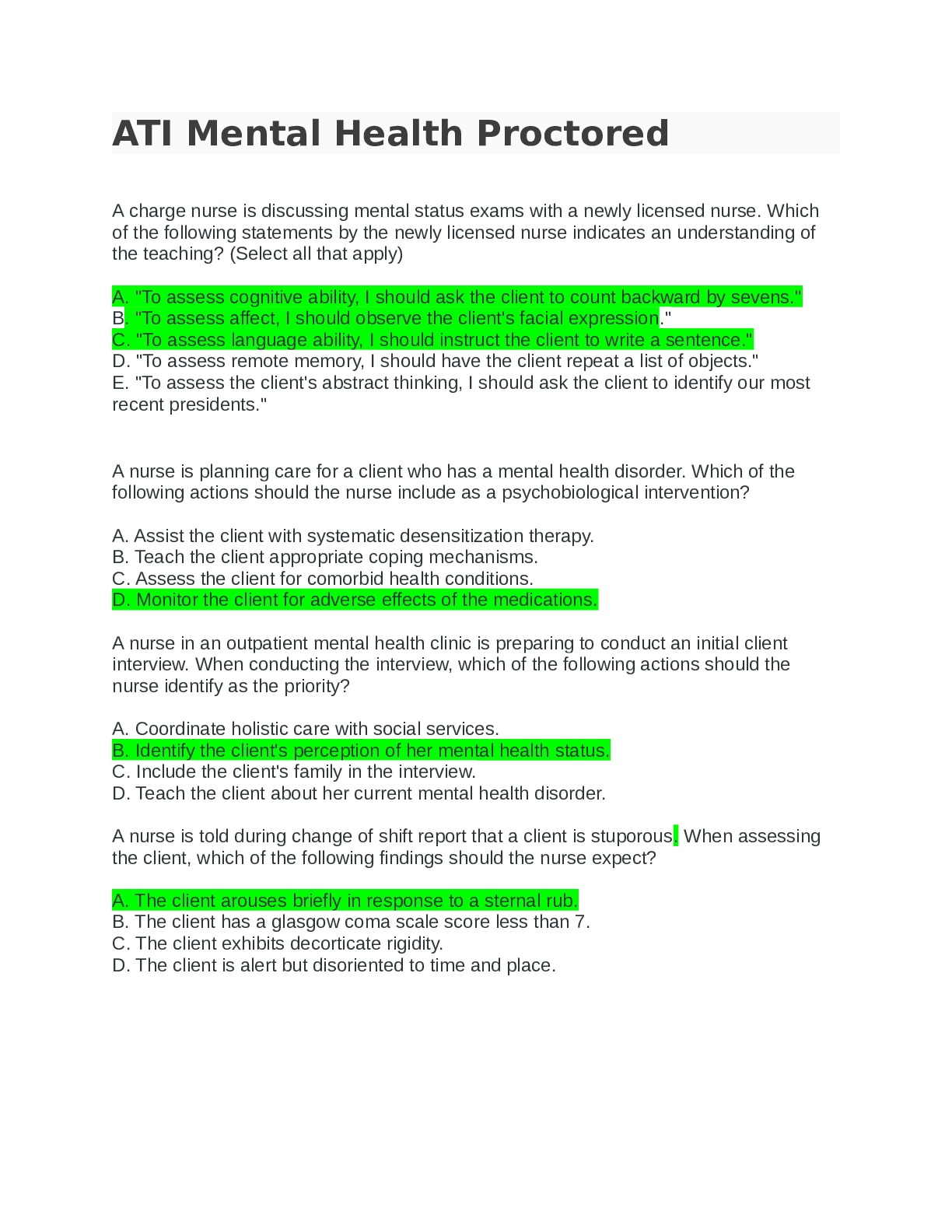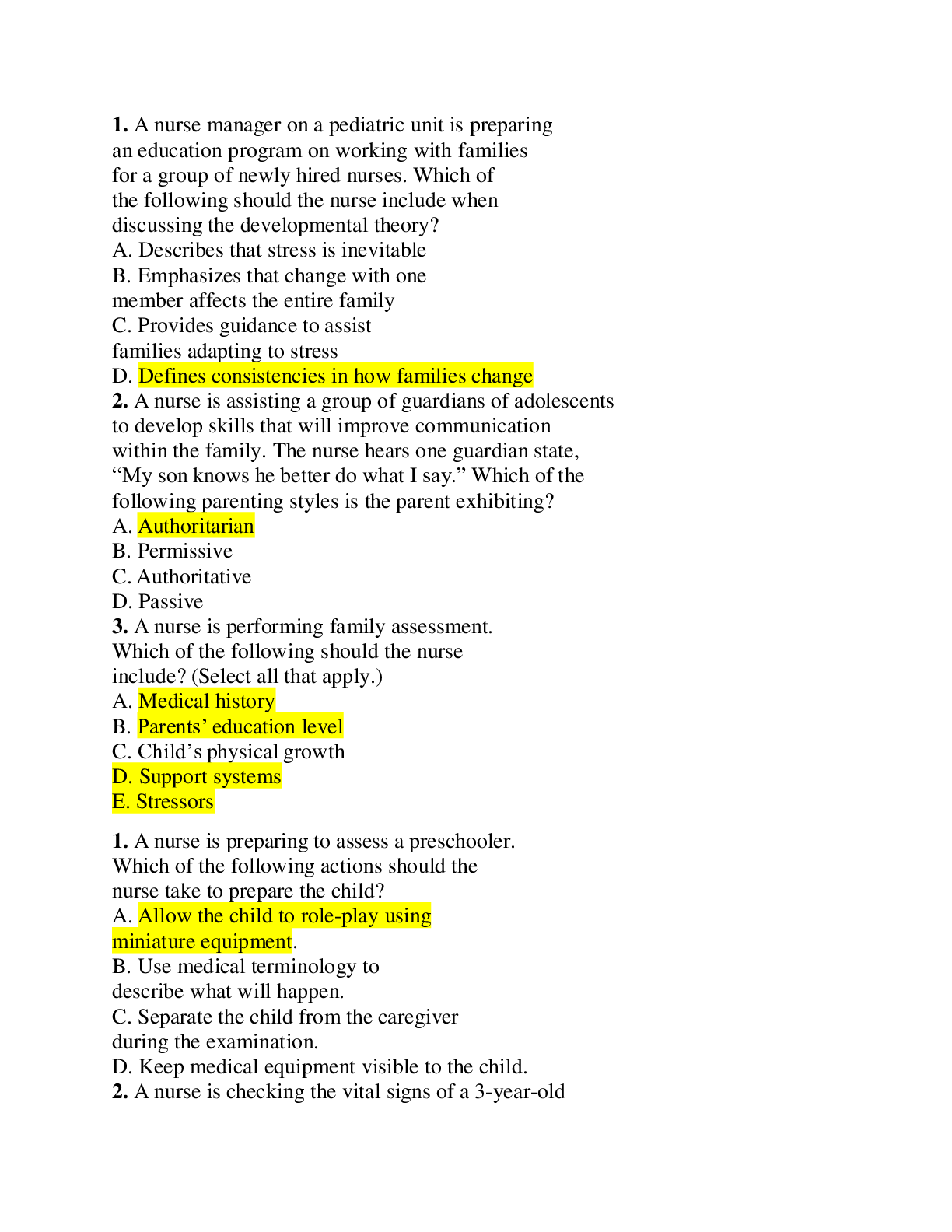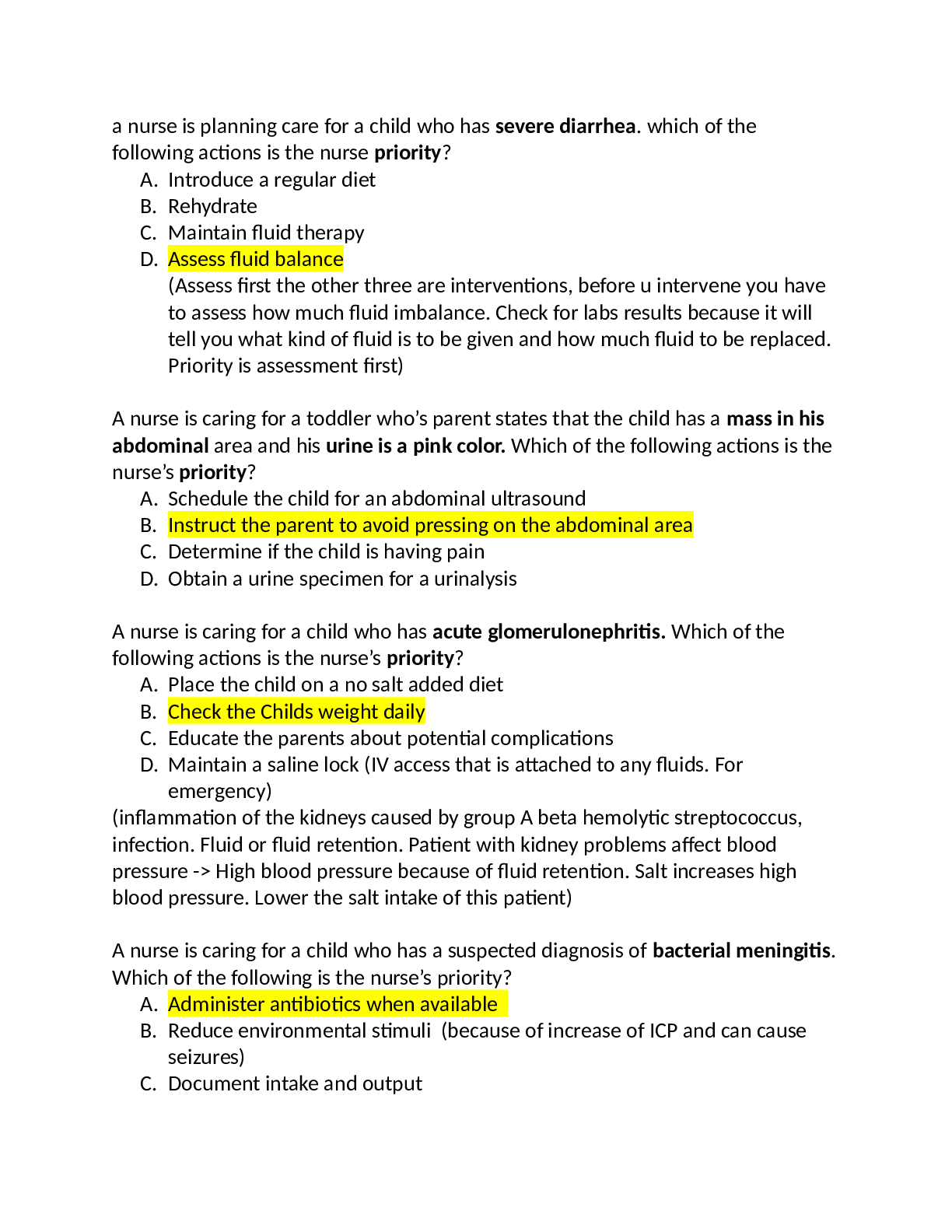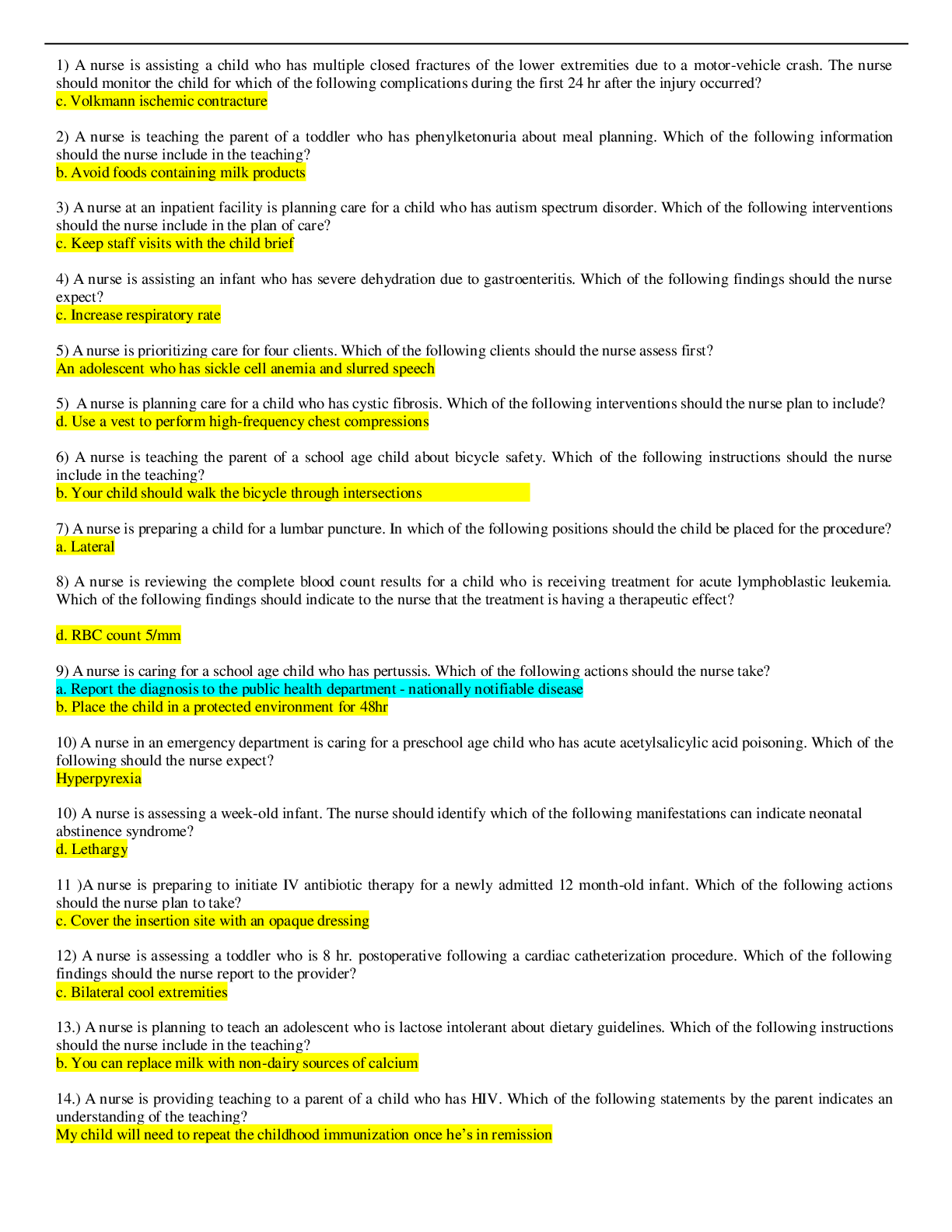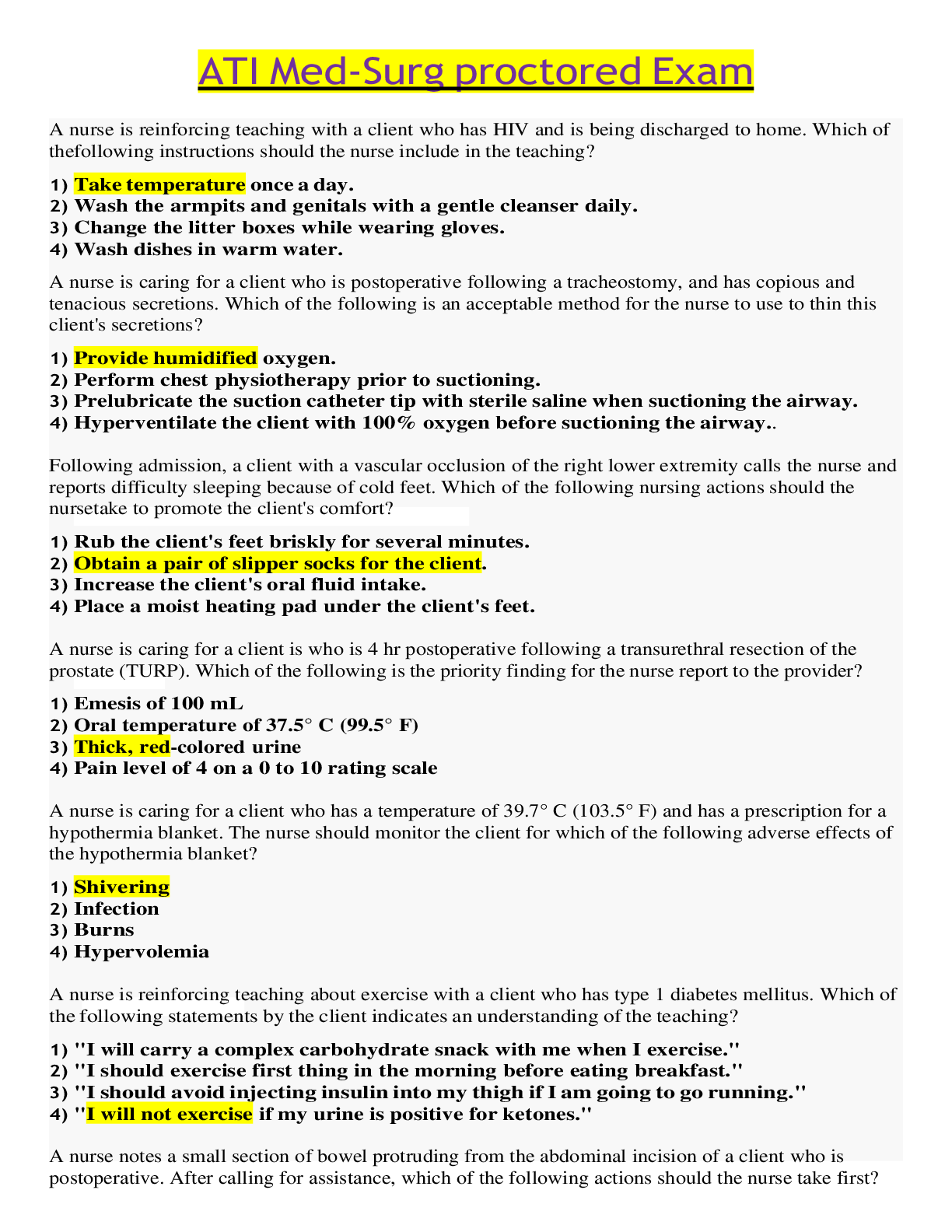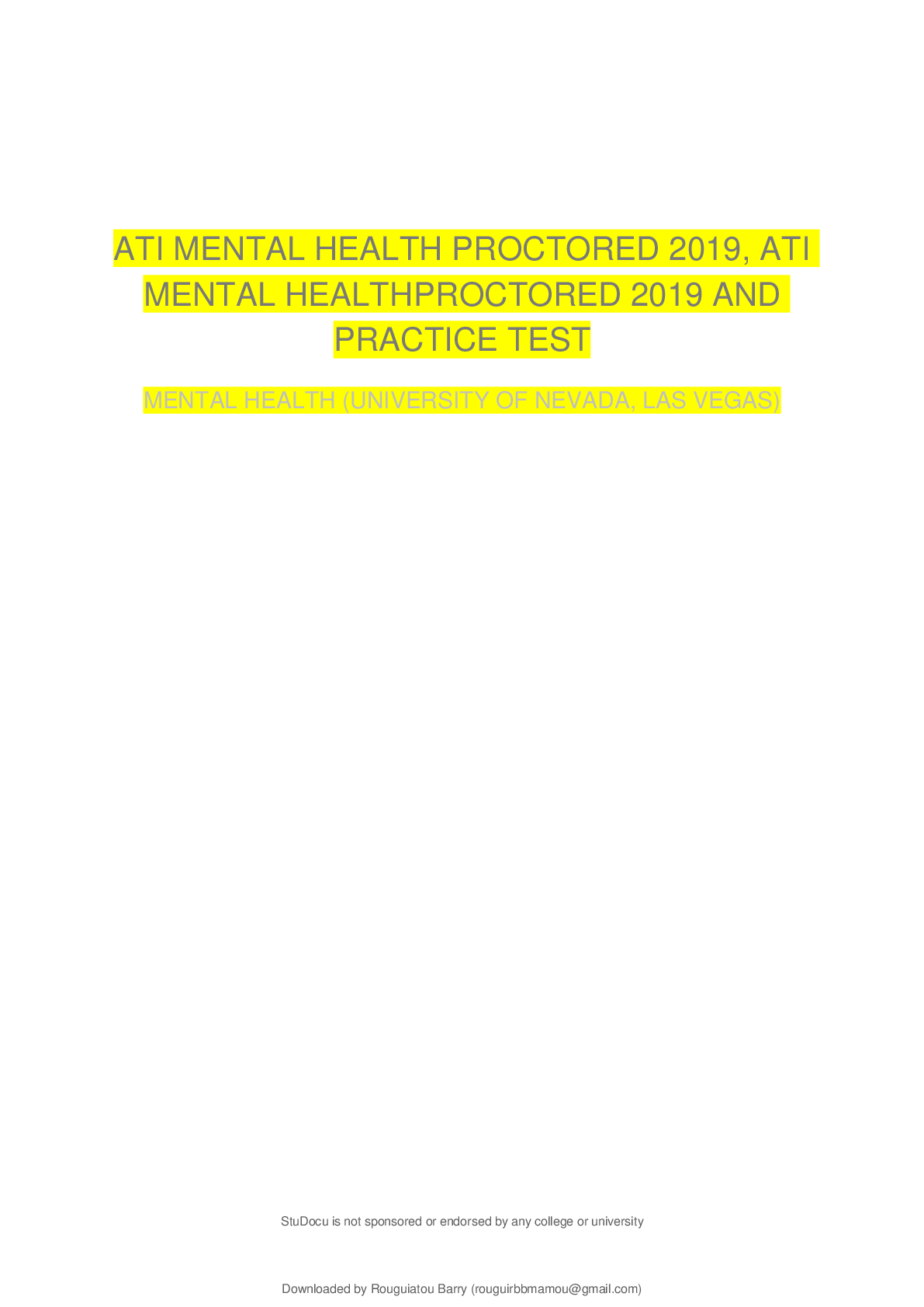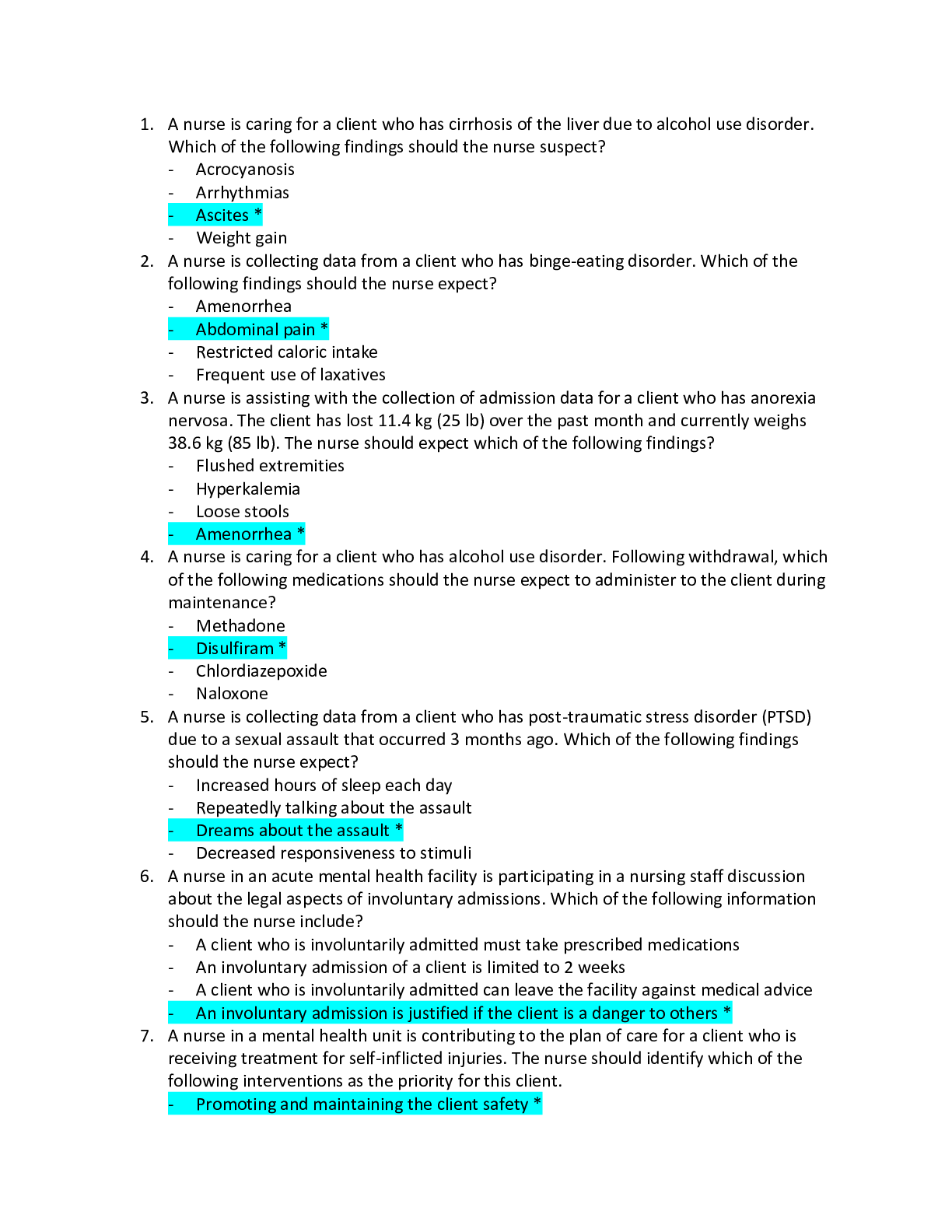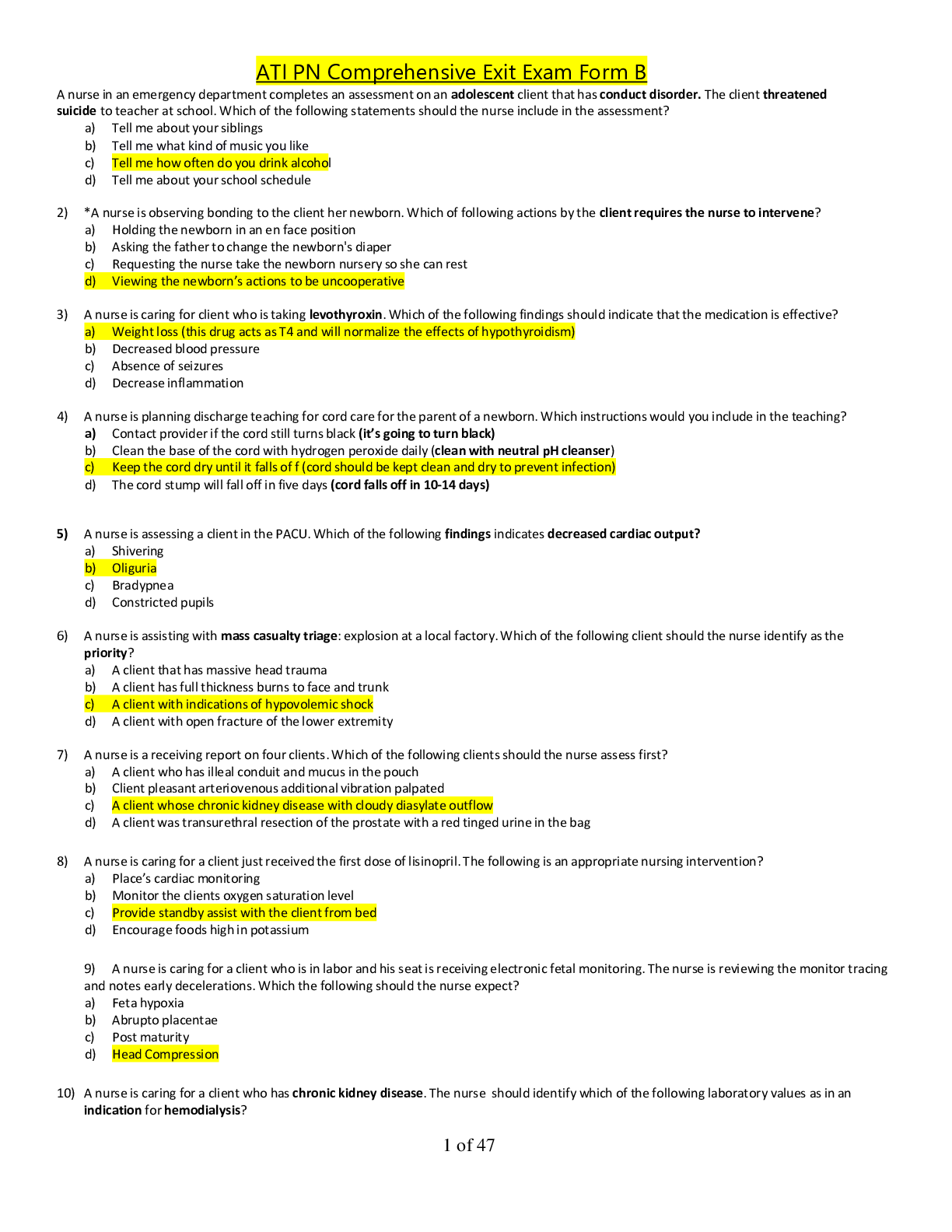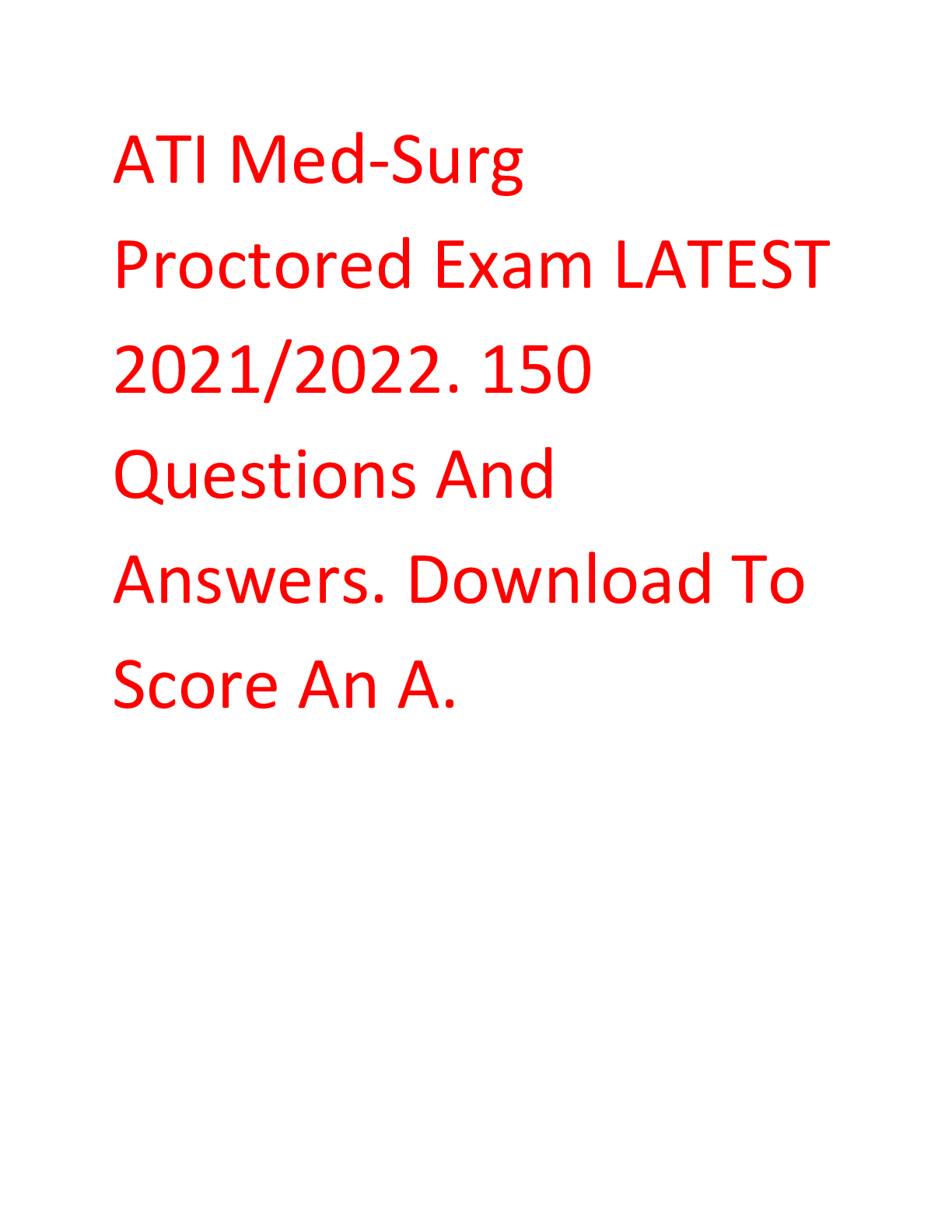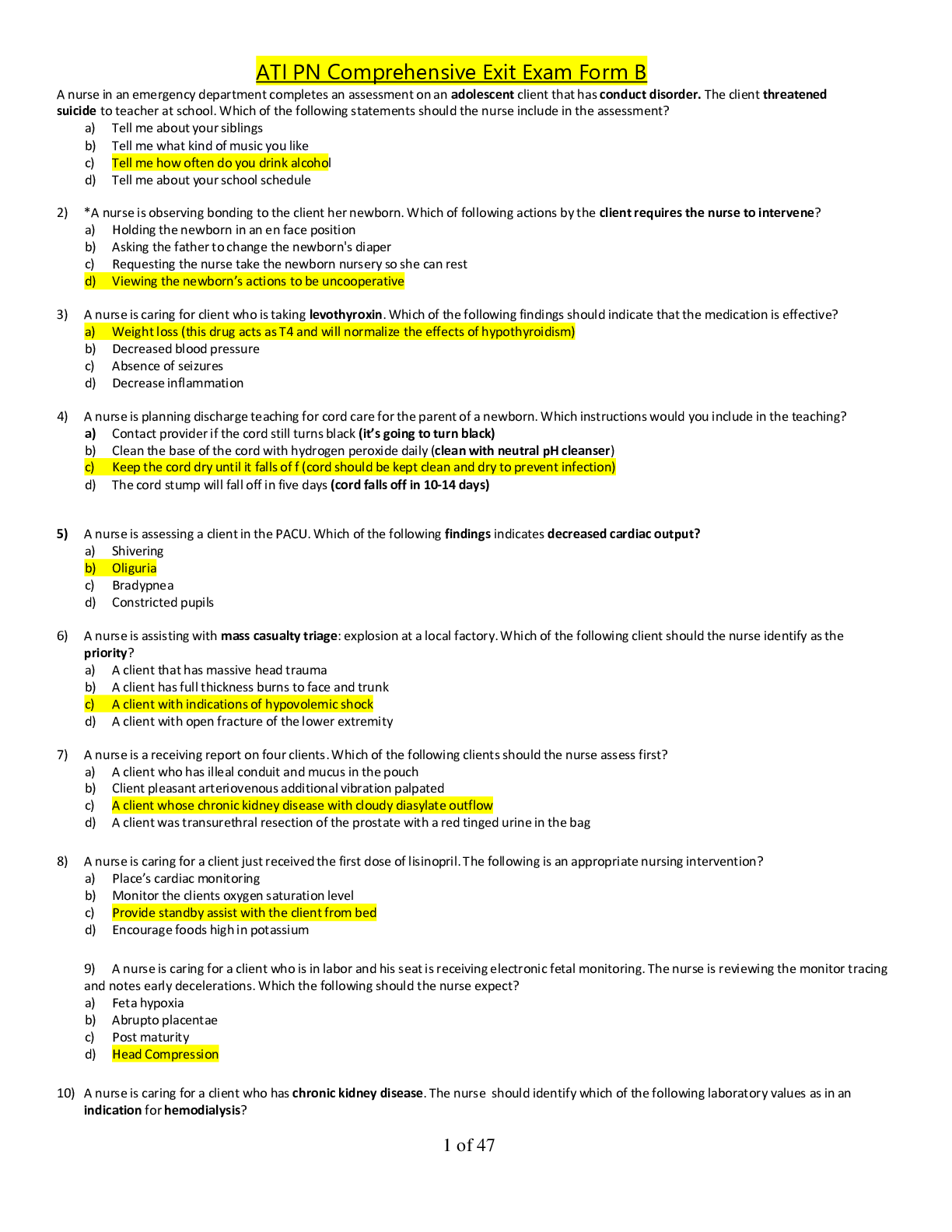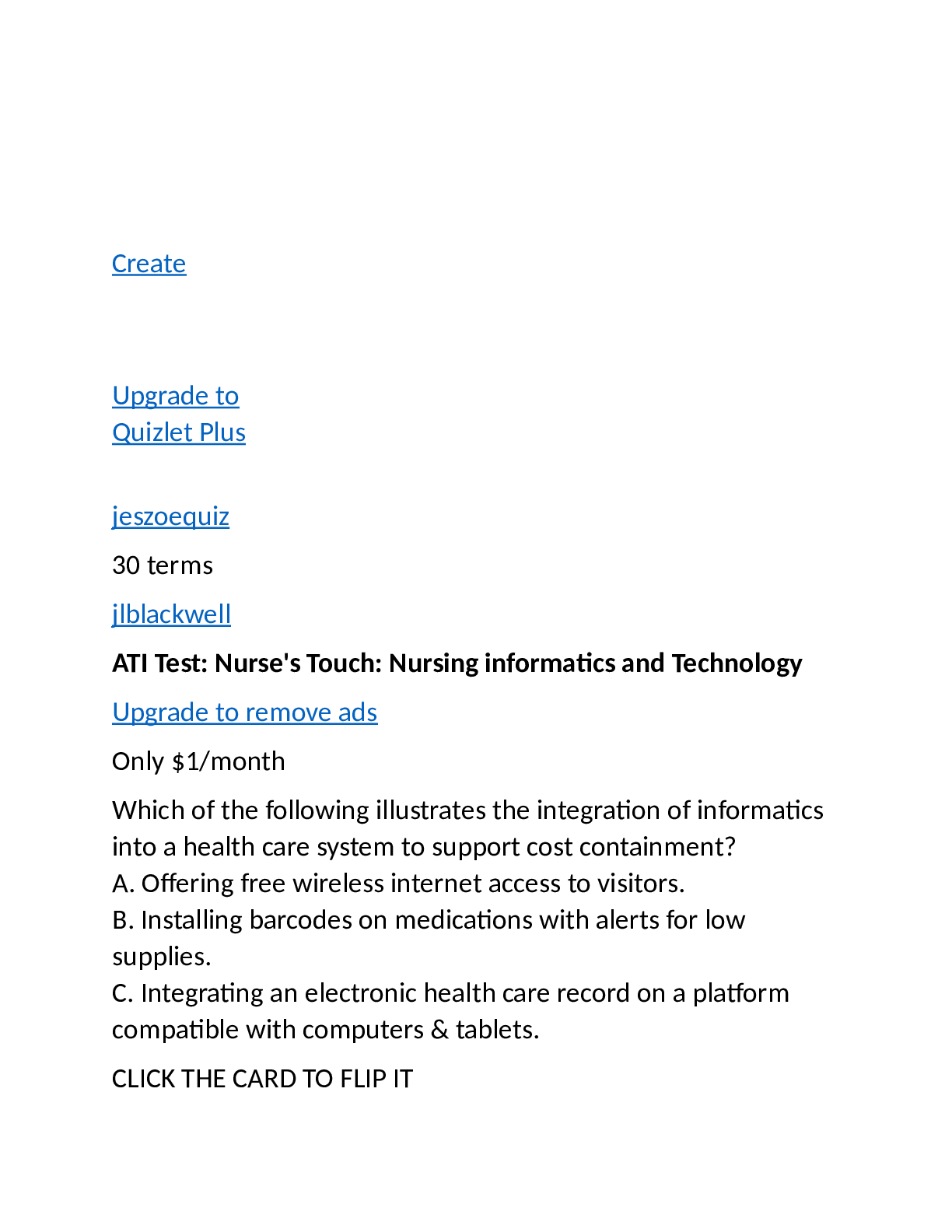*NURSING > ATI > ATI Mental Health Proctored 2019 (100% CORRECT SOLUTION) | Download To Score An A (All)
ATI Mental Health Proctored 2019 (100% CORRECT SOLUTION) | Download To Score An A
Document Content and Description Below
lOMoARcPSD|9330356 ATI Mental Health Proctored 2019 Psychiatric Nursing (Northern Virginia Community College) ... StuDocu is not sponsored or endorsed by any college or university ATI Mental Health Proctored Exam 2019 1. A client is fearful of driving and enters a behavioral therapy program to help him overcome his anxiety. Using systematic desensitization, he is able to drive down a familiar street without experiencing a panic attack. The nurse should recognize that to continue positive results, the client should participate in which of the following? a. Biofeedback b. Therapist modeling c. Frequent pacing d. Positive reinforcement 2. A nurse is counseling a client following the death of the client’s partner 8 months ago. Which of the following client statements indicates maladaptive grieving? a. “I am so sorry for the times I was angry with my partner.” b. “I like looking at his personal items in the closet.” c. “I find myself thinking about my partner often.” d. “I still don’t feel up to returning to work.” Rationale: 8 months too long Maladaptive Grief: . Distorted or exaggerated grief response - unable to perform activities of daily living. RISK FACTORS FOR MALADAPTIVE GRIEVING ●● Being dependent upon the deceased ●● Unexpected death at a young age, through violence, or by a socially unacceptable manner ●● Inadequate coping skills or lack of social support ●● Pre-existing mental health issues, such as depression or substance use disorder 3. /21 A nurse in an inpatient mental health facility is assessing a client who has schizophrenia and is taking haloperidol (anti-psychotic, 1st gen). Which of the following clinical findings is the nurse’s priority? a. Headache b. Insomnia (sedation) c. Urinary hesitancy (Complication → ANTIcholinergic effects) d. High fever (Complication → agranulocytosis) Other complications: Acute dystonia, Pseudoparkinsonism, Akathisia, Tardive dyskinesia, Neuroendocrine effects (Gynecomastia, Weight gain, Menstrual irregularities), NMS, Orthostatic Hypotension, Sedation, Sexual dysfunction, Skin effects, Liver impairment 4. A nurse is planning care for a client who has obsessive compulsive disorder. Which of the following recommendations should the nurse include in the client’s plan of care? a. Reality Orientation therapy (re-orient to reality) b. Operant Conditioning (receives positive rewards for positive behavior) c. Thought Stopping (say “stop” when compulsive behaviors arise & substitute w/ positive thought) d. Validation Therapy (acknowledging pt’s feelings) 4. A nurse is providing teaching to the daughter of an older client who has obsessive-compulsive disorder. Which of the following statements by the daughter indicates an understanding of the teaching? a. “I will provide my mother with detailed instructions about how to perform self-care.” (Give simple directions) b. “I will limit my mother’s clothing choices when she is getting dressed.” (If client is indecisive, limit the client's choices; if client still unable to make a decision, give client one outfit to wear) c. “I will wake my mother up a couple of times in the night to check on her.” d. “I will discourage my mother from talking about her physical complaints.” 5. A nurse is caring for a client who is in the manic phase of bipolar disorder. Which of the following actions should the nurse take? a. Provide in depth explanation of nursing expectations (inability to focus - give concise explanations) b. Encourage the client to participate in group activities (decrease stimulation) c. Avoid power struggles by remaining neutral (do not react personally to pt’s comments) d. Allow the client to set limits for his behavior (nurse sets limits) 6. A nurse is providing behavioral therapy for a client who has OCD. The client repeatedly checks that the doors are locked at night. Which of the following instructions should the nurse give the client when using thought stopping technique? a. “Keep a journal of how often you check the locks each night.” b. “Ask a family member to check the locks for you at night.” c. “Focus on abdominal breathing whenever you go to check the locks.” d. “Snap a rubber band on your wrist when you think about checking the locks.” Thought stopping: teach pt to say “stop” when negative thoughts/compulsive behaviors arise & substitute positive thought - goal for pt use command silently over time 7. A nurse is caring for a client who has a cocaine use disorder. Which of the following manifestations should the nurse expect the client to have during withdrawal? a. Hand tremors (Intoxication) b. Fatigue c. Seizures (Intoxication) d. Rapid speech Rationale: Pg: 97 WITHDRAWAL MANIFESTATIONS● Depression, fatigue, craving, excess sleeping or insomnia, dramatic unpleasant dreams, psychomotor retardation, agitation● Not life-threatening, but possible occurrence of suicidal ideation Cocaine = STIMULANT → OPPOSITE of HEROIN ● Withdrawal = opposite effects 8. A nurse is reviewing the medical record of a client who is taking clozapine. For which of the following findings should the nurse withhold the medication and notify the provider? a. WBC count b. Heart rate c. Report of photosensitivity d. Blood glucose level 9. /59. A nurse is creating a plan of care for a client who has major depressive disorder. Which of the following interventions should the nurse include in the plan? a. Keep the ring light on in the client’s room at night b. Encourage physical activity for the client during the day c. Identity and schedule alternative group activities for the client d. Discourage the client from expressing feeling of anger 10. A nurse is assessing a client who is experiencing acute alcohol withdrawal. Which of the following findings should the nurse expect? a. Diminished reflexes b. Hypotension - increased BP c. Insomnia d. Bradycardia 11. A nurse is caring for a client who has schizophrenia and displays severe symptoms of the disorder. Which of the following actions should the nurse take? a. Use medication to decrease frequency of auditory and visual hallucinations b. Assist the client to identify somatic and thought broadcast delusion (Identify symptom triggers, such as loud noises (can trigger auditory hallucinations in certain clients) and situations that seem to trigger conversations about the client’s delusions. c. Manage the client’s loud, rambling, and incoherent communication patterns d. Direct the client to perform her own daily hygiene and grooming tasks Somatic delusions - believes that his body is changing in an unusual way, such as growing a third arm. Thought broadcasting - believes that her thoughts are heard by others. Schizophrenia: The client has psychotic thinking or behavior present for at least 6 months. Areas of functioning, including school or work, self-care, and interpersonal relationships, are significantly impaired. 12. A nurse is caring for a client who was involuntarily committed and is scheduled to receive electroconvulsive therapy. The client refuses the treatment and will discuss why with the healthcare team. Which of the following actions should the nurse take? a. Document the client’s refusal of the treatment in the medication record b. Tell the client he cannot refuse the treatment because he was involuntarily committed c. Inform the client the ECT does not require client consent d. Ask the client family to encourage the client to receive ECT Clients admitted under involuntary commitment are still considered competent and have the right to refuse TX,. 13. A nurse is providing crisis intervention for a client who was involved in a violent mass casualty situation in the community. Which of the following actions should the nurse take during the initial session with the client? a. Identify the client’s usual coping style. b. Encourage the client to display anger toward the cause of the crisis. (Reduce stress-related manifestations, such as using techniques to alleviate a panic attack) c. Tell the client that this life will soon return to normal (False assurance) d. Help the client focus on a wide variety of topics regarding the crisis. (Reduce stress) 14. A nurse in the emergency department is caring for a client who reports feeling sad, worthless, and hopeless 9 months after the death of her son. Which of the following actions should the nurse take first? a. Encourage the client to attend a grief support group b. Discuss the client’s coping skills c. Request a mental health consult for the client d. Ask the client if she has thought about harming herself given - she’s showing signs of depression and no reason to live so we asked if she's going to commit suicide. Feelings of powerlessness and isolation and death of a loved one are risk factors. 15. A nurse is planning care for an adolescent who has autism spectrum disorder. Which of the following outcomes should the nurse include in the plan of care? a. Acknowledges that his delusions are not real b. Changes behavior as a result of peer pressure c. Initiate social interactions with caregiver pl with autism have a problem with communicating and interacting with others. They also have an inability to make eye contact . d. Meets own needs without manipulating others. 16. A nurse is caring for a client who is experiencing active auditory hallucination. Which of the following should the nurse take? a. Avoid asking direct questions about the client’s experience b. Tell the client her experience is not real c. Convey sympathy for her client’s experience d. Focus the client on reality based activities attempt to focus conversation on reality based subjects. 17. A nurse is conducting an admission interview with a client who is experiencing mania. Which of the following findings the nurse reports to the provider? a. Reports eating twice in the past week (physical exhaustion & possible death - MEDICAL EMERGENCY) b. States that he hasn't bathed in 2 days c. Speaks in rhyming sentences d. Makes inappropriate sexual comments 18. A nurse is caring for a client who has anorexia nervosa. Which of the following findings requires immediate intervention by the nurse? a. Lanugo covering the body b. Blood pH 7.40 c. +2 edema of the lower extremities Hypokalemia due to purging/vomiting → dehydration → inc aldosterone production → Na & water retention & K excretion d. BUN 21 mg/dL 19. A nurse is planning care for a client who has a recent diagnosis of antisocial personality disorder. Which of the following outcomes should the nurse in the care plan? a. The client treats others with respect b. The client recognizes the importance of others c. The client reduces self-dramatization d. The client conforms to social norms regarding clothing choices Antisocial personality disorder: disregard for others w/ exploitation, lack of empathy, repeated unlawful actions, deceit, & failure to accept personal responsibility; sense of entitlement, manipulative, impulsive, & seductive; nonadherence to traditional morals & values; verbally charming & engaging 20. A nurse is caring for a client who is prescribed massage therapy to treat panic disorder. The client states “I can't stand to be touched by another person”. Which of the following response should the nurse make? a. Why don't you like to be touched by others? (don’t ask “why” questions) b. I will request that the massage therapist wear gloves during your treatment (till being touched) c. I will tell your provider know that you would like a treat other than a message (avoid triggers) d. Don't worry about it. Your anxiety will lessen once the massage begins (false reassurance, minimizing feelings) 21. A nurse in a group home facility is caring for a client who is developmentally disabled. The client has been stealing belongings from the other clients. Which of the following techniques should the nurse use? a. Crisis intervention to decrease anxiety b. Aversion therapy to provide distraction (Pairing of a maladaptive behavior with a punishment or unpleasant stimuli to promote a change in the behavior) c. Systematic desensitization to extinguish the behavior (Anxiety) d. Positive reinforcement to increase desired behavior 22. A nurse in a mental facility is caring for a newly admitted client. Which of the following resources should the nurse recommend to help the client adapt to the healthcare setting? a. A Community meeting b. A Mediation group c. A Symptom management group d. A Self-help meeting 23. A nurse is teaching the caregiver of a client who has advanced Alzheimer’s disease about home safety. Which of the following statements by the caregiver indicates an understanding of the teaching? a. I will give his most recent photo to the police b. I will place a sliding bolt lock just above the doorknob (locks prevent wandering outside) c. I will ensure the bedroom is dark while he is sleeping at night (well lit environment) d. I will notify law enforcement within 2 hours if he cannot be found 24. A nurse is beginning a therapeutic relationship with a client. The nurse should plan to accomplish which of the following tasks during the working phase? a. Establish boundaries between the nurse and the client b. Evaluate progress toward predetermined goals c. Inform the client about confidentiality rights d. Set short- and long-term objective for the future 25. A nurse Is planning care for a client who has anorexia nervosa and is admitted to an inpatient eating disorder unit. Which of the following is an appropriate intervention? (p. 167) a. Use systematic desensitization to address the client’s fears regarding weight gain b. Allow the client to select meal times (A structured and inflexible eating schedule at the start of therapy, only permitting food during scheduled times, promotes new eating habits and discourages binge or binge-purge behavior.) c. Initiate a relationship built on trust with the client. d. d. Negotiate with the client the opportunity to reweigh. Systematic desentization: planned, progressive, or graduated exposure to anxiety-provoking stimuli - Gradually expose the client to a food starting with small amounts, stay with them to assist with relaxation I guess C is more right though?? EWAN 26. A nurse is providing discharge teaching about manifestations of relapse to the family of a client who has schizophrenia. Which of the following information should the nurse include in the teaching? a. The client develops an inability to concentrate b. The client increases participation in social activities c. The client exhibits an inflated sense of self d. The client begins sleeping more than usual 27. A nurse in a mental health facility is caring for a client. Which of the following actions should the nurse take during the working phase of the nurse-client relationship? a. Summarize goals and objectives. b. Address confidentiality. c. Promote problem-solving skills. d. Establish a participation contract 27. A nurse is planning care for a client who has dementia. Which of the following interventions should the nurse include in the plan? a. Remove clocks from the client’s room (no want to orient to time) b. Confront the client when he exhibits inappropriate behavior (avoid confrontation) c. Give detailed instructions for completion of self-care activities (break instructions into short time frames) d. Provide finger food to enhance caloric intake (ensure adequate food/fluid intake) 28. A nurse is developing a teaching plan for the family of an older adult client who is to receive transcranial magnetic stimulation. Which of the following information should the nurse include in the teaching plans? a. The client might have a headache after treatment (a/e mild discomfort and tingling sensation at the site of the electromagnet) b. The client will require intubation after treatment (client is alert during the procedure) c. The client is at risk for aspiration during treatment (nothing is placed in the mouth, only a noninvasive magnet in the head) d. The client will experience a seizure during treatment (RARE) (ECT) 29. A nurse overhears a client saying, “I am a spy, a spy for the FBI. I am an I, an eye for an eye, an eye in the sky. Sky is up high. The nurse should document the client’s statement as which of the following speech alterations? a. Clang association Meaningless rhyming of words, often forceful, such as, “Oh fox, box, and lox.” b. Echolalia Repeating words spoken to him c. Word salad Words jumbled together with little meaning or significance to the listener, such as, “Hip hooray, the flip is cast and wide-sprinting in the forest.” d. Neologism Made-up words that have meaning only to the client, such as, “I tranged and flittled.” 30. A nurse is assessing a client who has neuroleptic malignant syndrome. Which of the following clinical findings should the nurse expect? a. Hypotonicity (muscle rigidity) b. Temperature 40 (104F) (sudden high fever) c. Heart rate 48/min (bradycardia) d. WBC 3,000/mm ●●Sudden high fever ●● Blood pressure fluctuations ●● Diaphoresis ●● Tachycardia ●● Muscle rigidity ●● Drooling ●● Decreased level of consciousness ●● Coma ●● Tachypnea 31. A nurse in an acute care mental health facility is planning discharge care for a client who sustained a traumatic brain injury. For which of the following needs should the nurse collaborate with a clinical psychologist? a. The client needs to begin a group therapy program prior to discharge b. The client needs to find a place to live after discharge. c. The client needs a prescription for medication to promote nighttime sleep while in the facility d. The client needs to relearn how to perform skills that require fine motor coordination. 32. A nurse is caring for a client who reports that he is angry with his partner because she is thinking he is just trying to gain attention. When the nurse attempts to talk to the client, he becomes angry and tells her to leave. Which of the following defense mechanism is the client demonstrating? a. Denial b. Displacement c. Compensation d. Rationalization Displacement - shifting feelings r/t to an object, person or situation to another less threatening object, person, or situation 33. A nurse is teaching a client who has schizophrenia about her new prescription for risperidone. Which of the following statements should be nurse include in the teaching? a. You should discontinue this medication if you develop muscle rigidity b. You will experience weight loss while taking this medication c. You will notice symptoms improve within 24 hours of taking this medication d. You should increase your consumption of complex carbohydrates (Risk of Metabolic Syndrome) 34. A nurse is talking to a client following a group therapy session. The client tells the nurse that one of the other clients in the group made an inappropriate comment. Which of the following responses should the nurse make? a. You sound upset about today’s session b. I agree that the comment was inappropriate c. Why do you think that he said that to you? d. I think you should ignore the comment 35. /46. A nurse is reviewing the laboratory report of a client who is taking carbamazepine for bipolar disorder. Which of the following laboratory results should the nurse report to the provider? a. RBC 4.7/mm b. Platelets 90,000/mm c. Urine specific gravity 1.029 d. Urine pH 5.6 Mood Stabilizing Antiepileptic drugs Complications: CNS effects, Blood dyscrasias, Teratogenesis, Hypoosmolarity (Monitor for edema, UO, HTN), Skin Disorders (Dermatitis, rash, Steven Johnson) 36. A nurse is providing teaching about disorder management for a client who has PTSD. Which of the following statements should the nurse include in the teaching? a. Response prevention is an effective treatment for PTSD b. You should try to limit the number of hours that you sleep each day c. Talking about the traumatic experience is recommended d. Avoiding stimuli that trigger memories of the trauma can help you overcome your PTSD 37. A nurse is providing teaching about disulfiram to a client who has a history of alcohol use. Which of the following instructions should the nurse include in the teaching? a. You will need to take the medication once daily b. You should avoid drinking carbonated beverages while taking the medication (Avoid Alcohol → Acetaldehyde Symptoms; cough syrup, aftershave lotion, mouthwash, hand sanitizer) c. You can expect to develop a physical dependence to the medication d. You will receive treatment in an inpatient setting e. You should avoid using mouthwash that contain alcohol 38. A nurse in a mental health facility is making plans for client’s discharge. Which of the following interdisciplinary team members should the nurse contact to assist the client with housing placement? a. Social worker b. Occupational therapist c. Clinical nurse specialist d. Recreational therapist 39. A nurse is providing teaching to a client who has depressive disorder and a new prescription for doxepin. Which of the following instructions should the nurse include in the teaching? a. Decrease the prescribed dose by half when mood improves b. Sit on the side of the bed for a few minutes before standing c. Eat a snack before going to bed d. Avoid over the counter magnesium when taking this medication TCA Complications: Orthostatic Hypotension, Anticholinergic Effects (Tachy), Sedation, Cardiac Toxicity (dysrhythmias, mental confusion, and agitation, which are followed by seizures, coma, and possible death), Decreased Seizure threshold, Excessive Sweating, Increased appetite 40. A nurse is caring for a client who has borderline personality disorder and has been engaging in self-mutilation. The nurse should encourage the client to participate in which of the following groups? a. Co-dependent’s Support Group b. Dual Diagnosis Treatment Group c. Desensitization Therapy (Anxiety) d. Dialectical Behavior Treatment Group used for clients who exhibit self-injurious behavior. It focuses on gradual behavior changes and provides acceptance and validation Codependent person reacts in over-responsible ways that allow the dependent individual to continue the substance use or addiction disorder. ● A partner can act as an enabler by calling the client’s employer with an excuse of illness when the client is intoxicated 41. A nurse is caring for a client following a physical assault. The client states, “I don't remember what happened to me.” The nurse should recognize that the client is using which of the following defense mechanism? a. Rationalization b. Repression c. Denial d. Displacement 42. A nurse is preparing to administer haloperidol 7mg IM to a client who is severely agitated. Available is haloperidol injection 5mg/mL. How many mL should the nurse administer? 1.4 mL 43. A charge nurse is discussing the care of a client who has a substance use disorder with a staff nurse. Which of the following statements by the staff nurse should the charge nurse identify as countertransference? a. The client is just like my brother who finally overcome his habit b. The client generally shares his feelings during group therapy sessions c. The client asked me to go on a date with him, but I refused d. The client needs to accept responsibility for his substance use Countertransference occurs when a health care team member displaces characteristics of people in her past onto a client. 44. A nurse is teaching a client who has a new prescription for phenelzine to treat depression. The nurse instructs the client to avoid foods with tyramine to prevent which of the following? a. Serotonin syndrome b. Hypertensive crisis c. Urinary retention d. Cardiac toxicity Hypertensive crisis: severe HTN as a result of intensive vasoconstriction and stimulation of the heart and can result from intake of dietary tyramine. Manifestations: headache, nausea, increased HR, increased BP Tyramine-rich foods include aged cheese, pepperoni, salami, avocados, figs, bananas, smoked fish, protein, some dietary supplements, some beers, and red wine. 45. A nurse is caring for a client who has a personality disorder and is using transference to cope. Which of the following behaviors should the nurse expect? a. Refusing to participate in group activities b. Reaction to the nurse as though she were his mother c. Expressing frustration regarding unit rules d. Talking negatively about other staff member Transference occurs when the client views a member of the health care team as having characteristics of another person who has been significant to the client’s personal life. 46. A nurse is admitting a client who has generalized anxiety disorder. Which of the following actions should the nurse plan to take first? a. Determine how the client handles stress I’m just thinking this cuz it said first and this seems like an assessment which is what you do first b. Ask the client to identify her strengths c. Provide the client with a quiet environment at the same time it is important to provide them with a calm quiet environment, but I think this one is if they are experiencing panic-level anxiety. Idk. I might be overthinking d. Teach the client to use guided imagery 47. A nurse is teaching a client who has bipolar disorder and a new prescription for lithium carbonate. Which of the following statements by the client indicates an understanding of the teaching? a. I should be on a low sodium diet - adequate sodium intake b. I should drink at least 6 liters of water per day - 1.5-3 L/day of water c. I will see my doctor to check my lithium level annually- monitor levels while undergoing TX. At start of TX, monitor q2-3 days until stable and then q1-3 months. d. I will call my doctor if I have a diarrhea -Diarrhea is an early indication of lithium toxicity 48. A nurse is caring for a client who is experiencing a panic attack. Which of the following actions should the nurse take? a. Place the client in seclusion -hmm...the wording seems harsh BUT, the immediate nursing action for a client with anxiety is to decrease stimuli in the environment and provide a calm and quiet environment. b. Ask the client to discuss precipitating events-for mild-moderate anxiety c. Have the client breathe into a paper bag (To help the hyperventilation, seclusion might give em more anxiety & leaving them alone during a panic attack isn't safe .. and it still seems like a restraint ..idk) d. Speak to the client in a high-pitched voice -use a low-pitched voice 49. A nurse is caring for a client who is starting treatment for substance use disorder. Which of the following actions indicates the nurse is practicing the ethical principle of nonmaleficence? a. Providing the client with quality care regardless of ability to pay for treatment Justice b. Withholding a prescribed meds that is causing adverse effects for the client c. Being truthful with the client about the manifestations of withdrawal veracity d. Educating the client about legal rights concerning treatment autonomy Nonmaleficence - the obligation to do or cause no harm to another 50. A nurse is caring for a client who has just returned to the unit after receiving an electroconvulsive therapy treatments. Which of the following assessments is the nurse’s priority? a. Return of bowel sounds b. First voiding c. Short term memory d. Presence of gag reflex 51. A nurse in the emergency department is counseling a client who reports experiencing intimate partner violence. Which of the following actions should the nurse take? a. Request permission from the client to take photographs of the injuries. b. Offer to help the client escape from the partner the next time violence occurs c. determine what the client did to trigger the violent incident. d. Tell the client that staying with the partner shows a lack of judgment. 52. A nurse is reviewing the medication administration record of a client who has schizophrenia. The nurse should plan to initiate the abnormal involuntary movement scale to monitor for adverse effects of which of the following medications? a. Amantadine b. Benztropine c. Diphenhydramine d. Haloperidol (Antipsychotic) 53. A nurse is planning overall strategies to address problems for a client who has borderline personality disorder. Which of the following strategies is the priority for the nurse to incorporate in the plan of care? a. Discuss the appropriate use of assertive behavior with the client b. Assist the client to maintain awareness of her thoughts and feelings c. Implement measures to prevent intentional self-inflicted injury d. Encourage the client to attend weekly support group meetings 54. A nurse is obtaining a medical history from a client who is requesting a prescription for bupropion for smoking cessation. Which of the following assessment findings in the client’s history should the nurse report to the provider? a. Knee arthroplasty 1 month ago b. Hepatitis B infection c. Recent head injury (Avoid administering to clients at risk for seizures, such as a client who has a head injury) d. Hypothyroidism Bupropion = ATYPICAL ANTIDEPRESSANT, inhibits Dopamine uptake ○ Alternative to SSRIs for clients unable to tolerate sexual dysfunction side effects ○ Complications: Headache, dry mouth, GI distress, constipation, increased heart rate, nausea, restlessness, insomnia Suppression of appetite = weight loss, contraindicated for those who have anorexia or bulimia 55. A nurse is caring for a client who has bipolar disorder and is experience a manic episode. Which of the following actions should the nurse take? a. Administer methylphenidate to the client b. Encourage the client to join group activities c. Dim the lights in the client’s room d. Provide detailed explanations to the client 56. A nurse is caring for a client who is admitted to a mental health facility after attempting suicide. Which of the following actions should the nurse take first? a. Implement continuous one to one observation b. Establish a rapport to foster trust c. Ask the client to sign a no suicide contract d. Encourage the client to participate in group therapy 57. A nurse in an outpatient clinic is assessing a client who has anorexia nervosa. Which of the following findings indicates the need for hospitalization? a. Temperature 35.6 (96.1) Temp less than 36C (96.8F) b. Heart rate 56/min (Less than 40/min) c. Potassium 3.8meq/L d. Weight 10% below ideal weight (Weight loss greater than 30% of body weight over 6 months) 58. A nurse is providing teaching for a newly licensed nurse about the constructive use of defense mechanisms. Which of the following examples should the nurse include in the teaching? a. A school age child whose mother died 2 years ago talks about her in present tense b. An adult who was sexually abused as a child is unable to remember the incident c. A woman who has a health concern postpones a medical appt until after a vacation. d. A student who is upset with her teacher writes a story about an excellent student 59. A nurse is caring for a client who has a prescription for phenelzine. The nurse should instruct the client to avoid which of the following over the counter medications? a. Ibuprofen b. Docusate sodium c. Ranitidine d. Pseudoephedrine (Increases Hypertension) 60. An older adult client is brought to the mental health clinic by her daughter. The daughter reports that her mother is not eating and seems uninterested in routine activities. The daughter states, “I’m so worried that my mother is depressed.” Which of the following responses should the nurse make? a. “Tell me the reasons you think your mother is depressed.” b. “You shouldn't worry about this, because depressive disorder is easily treated.” c. “Everyone gets depressed from time to time.” d. “Older adults are usually diagnosed with depressive disorder as they age.” 61. A nurse is planning care for a newly admitted client who has anorexia nervosa. Which of the following interventions should the nurse include in the plan? a. Negotiate with the client how much weight she should gain each week b. Weigh the client weekly for the first month c. Notify the client about designated times for meals d. Decrease the client’s daily intake of fiber 62. A nurse in a community health facility is interviewing a client who recently lost his job. The client states “I was fired because my boss doesn't like me”. Which of the following defense mechanisms is the client displaying? a. Dissociation b. Rationalizations c. Displacement d. Repression Rationale: pg 22: Rationalization: creating reasonable and acceptable explanations for unacceptable behavior Dissociation: lack of connect between the person’s identity, memory, or how they perceive the environment. Repression: Unconsciously putting unacceptable ideas, thoughts, and emotions out of awareness. Displacement: Shifting feelings related to an object, person, or situation to another less threatening object, person, or situation. 1.A nurse in an alcohol treatment facility is caring for a client who states, “My job is so stressful that the only way I can cope is to drink.“ The nurse should recognize that the client is displaying which of the following defense mechanisms? a. Introjection (Unconscious adoption of the ideas or attitudes of others) b. Repression c. Rationalization d. Intellectualization 63. A nurse is providing counseling for a family that consists of two parents and their two adolescents’ children. Which of the following family members should the nurse identify as acting in the role of monopolizer? a. The father who intervenes whenever the siblings argue b. The mother who expresses hostility toward her spouse c. The adolescent son who refuses to share personal feelings d. The adolescent daughter who attempts to dominate the discussion 64. A nurse is caring for a client in a mental health facility. The client is agitated and threatens to harm herself and others. Which of the following the nurse’s priority intervention? a. Put the client in seclusion b. Place the client in restraints c. Administers an anti-anxiety medication to the client d. Set limits on the client’s behavior 65. A nurse is assessing a client who has bipolar disorder and is taking lamotrigine. Which of the following findings is the nurse’s priority? a. Thyroid- stimulating hormone (TSH) 4.0 microunits/mL b. Epitaxis c. Alanine transaminase (ALT) 20 IU/L d. Skin rash Rationale: page 133: adverse effects: double or blurred vision, dizziness, HA, nausea, vomiting, SERIOUS SKIN RASHES like Stevens-Johnson syndrome. Instruct the client to withhold the medication, and notify the provider if a rash occurs 66. A nurse is assessing a young adult female client for schizophrenia. Which of the following findings should the nurse identify as a risk factor for this condition? a. Birth Order b. Environmental stress c. Gender d. Depression 67. A nurse is caring for a client in an inpatient mental health facility. The client tells the nurse that the government is reading her mail. Which of the following responses should the nurse make? a. “All of your letters come sealed, so that seems unlikely.” b. “Why do you think the government wants to read your mail.” c. “ It must be frightening to think that someone is reading your mails.” d. “You know that's not true, because it is against the law for others to read your mail.” Rationale: therapeutic communication 68. A nurse is assessing a client who is restless and constantly mutters to himself. Which of the following findings should lead the nurse to suspect delirium? a. The client’s speech is slow and repetitious b. The client is unable to recognize objects c. The client’s manifestation developed suddenly d. The client has a flat affect 69. A nurse is leading a crisis intervention group for adolescents who witnessed the suicide of a classmate. Which of the following actions should the nurse take first? a. Initiate referrals b. Discuss the importance of confidentiality c. Review community resources d. Identify prior coping skills 6. A nurse is providing crisis intervention for a client who was involved in a violent mass casualty situation in the community. Which of the following actions should the nurse take during the initial session with the client? a. Identify the client’s usual coping style. b. Encourage the client to display anger toward the cause of the crisis. (Reduce stress-related manifestations, such as using techniques to alleviate a panic attack) c. Tell the client that this life will soon return to normal (False assurance) d. Help the client focus on a wide variety of topics regarding the crisis. (Reduce stress) 70. A nurse is caring for a client who has borderline personality disorder. Which of the following outcomes should the nurse include in the treatment plan? a. The client will attend to personal hygiene b. The client will verbalize improve mood c. The client will report a decreased in hallucinations d. The client will communicate needs. 33. A nurse is assisting with obtaining informed consent for a client who has been legally incompetent. Which of the following actions should the nurse take? a. Explain implied consent to the client’s family. b. Contact the facility social work to obtain the consent. c. Request that the client’s guardian sign the consent d. Ask the charge nurse to obtain informed consent. Client who has been judged incompetent has a temporary or permanent guardian appointed by the court. The guardian can sign the informed consent for the client. [Show More]
Last updated: 1 year ago
Preview 1 out of 23 pages
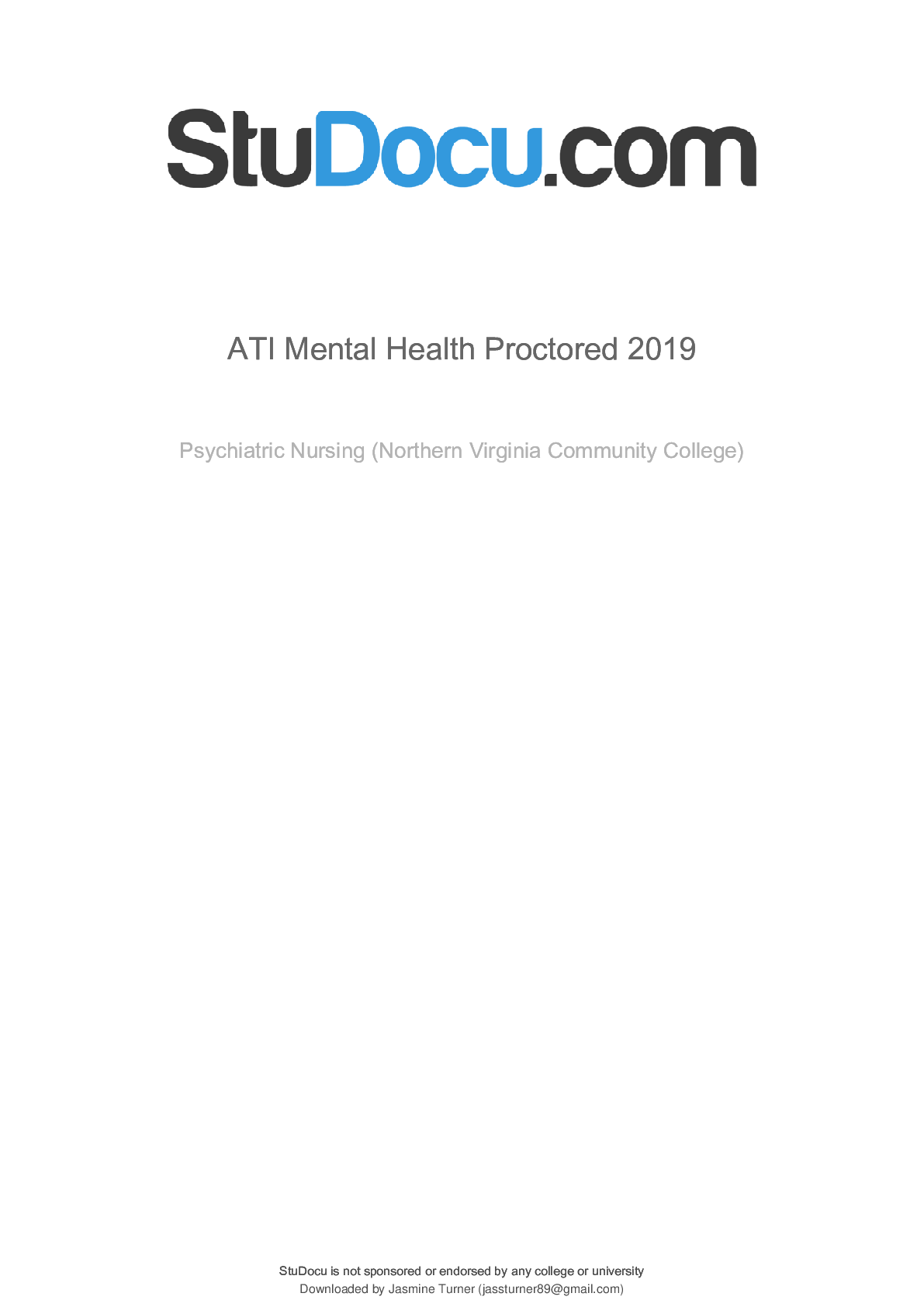
Reviews( 0 )
Document information
Connected school, study & course
About the document
Uploaded On
May 27, 2022
Number of pages
23
Written in
Additional information
This document has been written for:
Uploaded
May 27, 2022
Downloads
0
Views
49

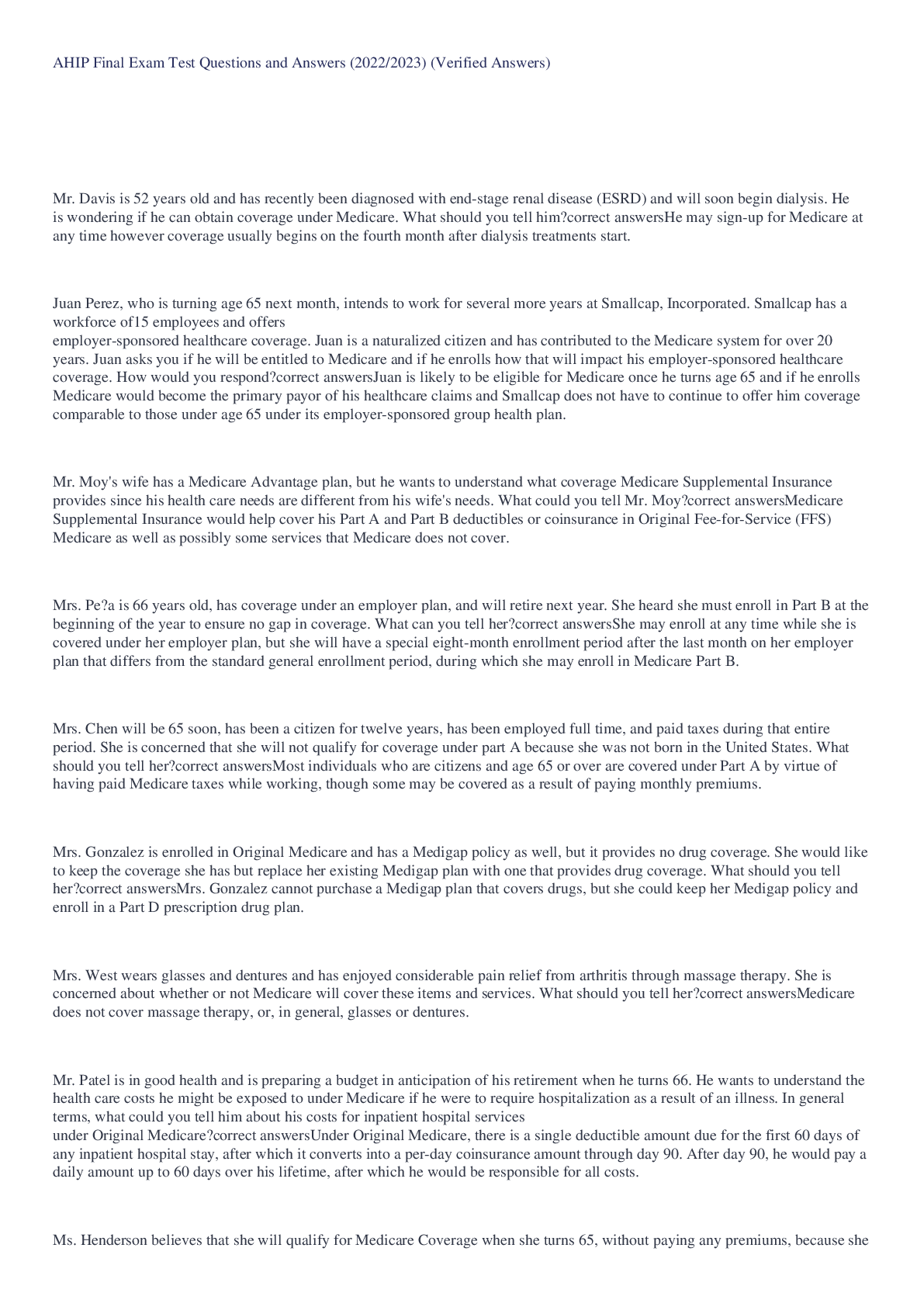

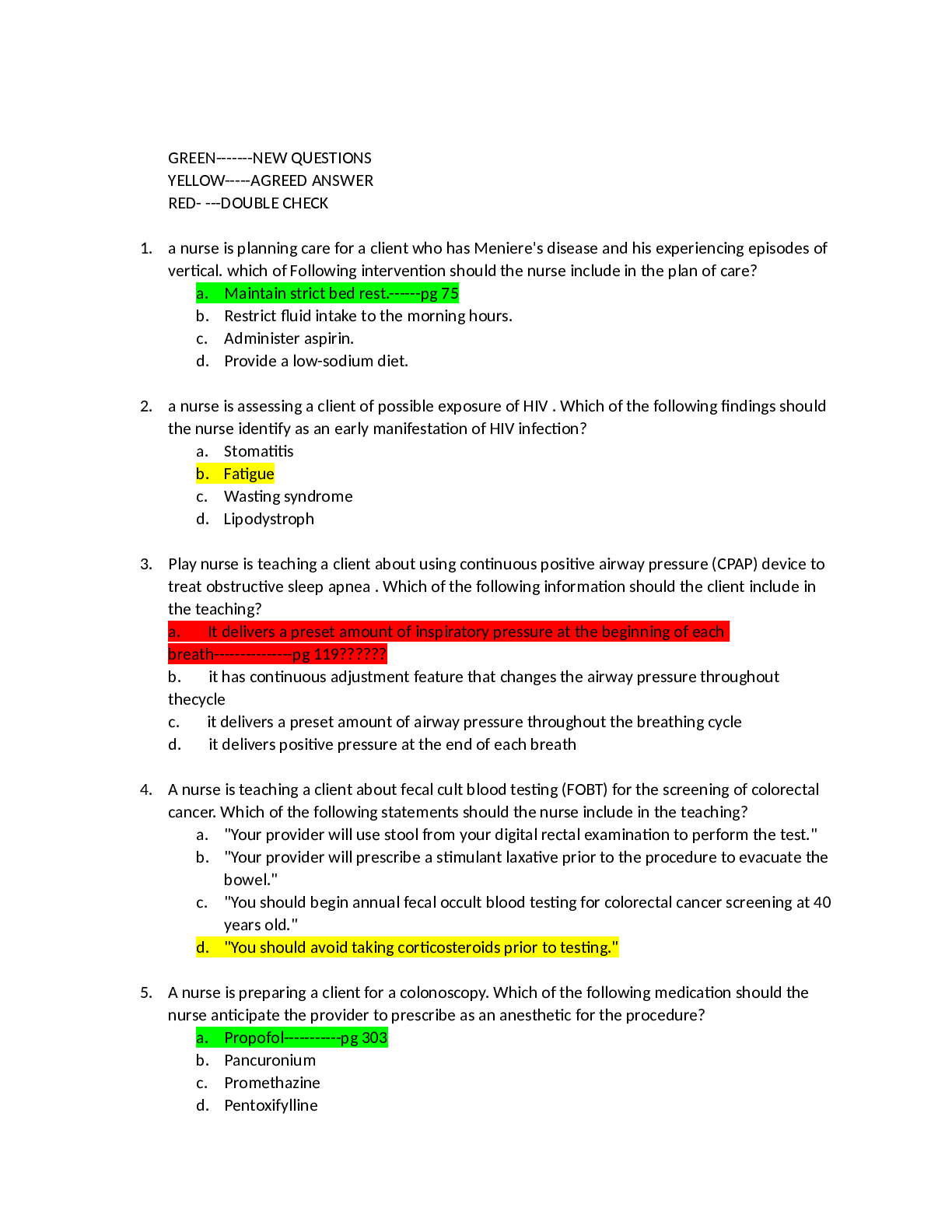
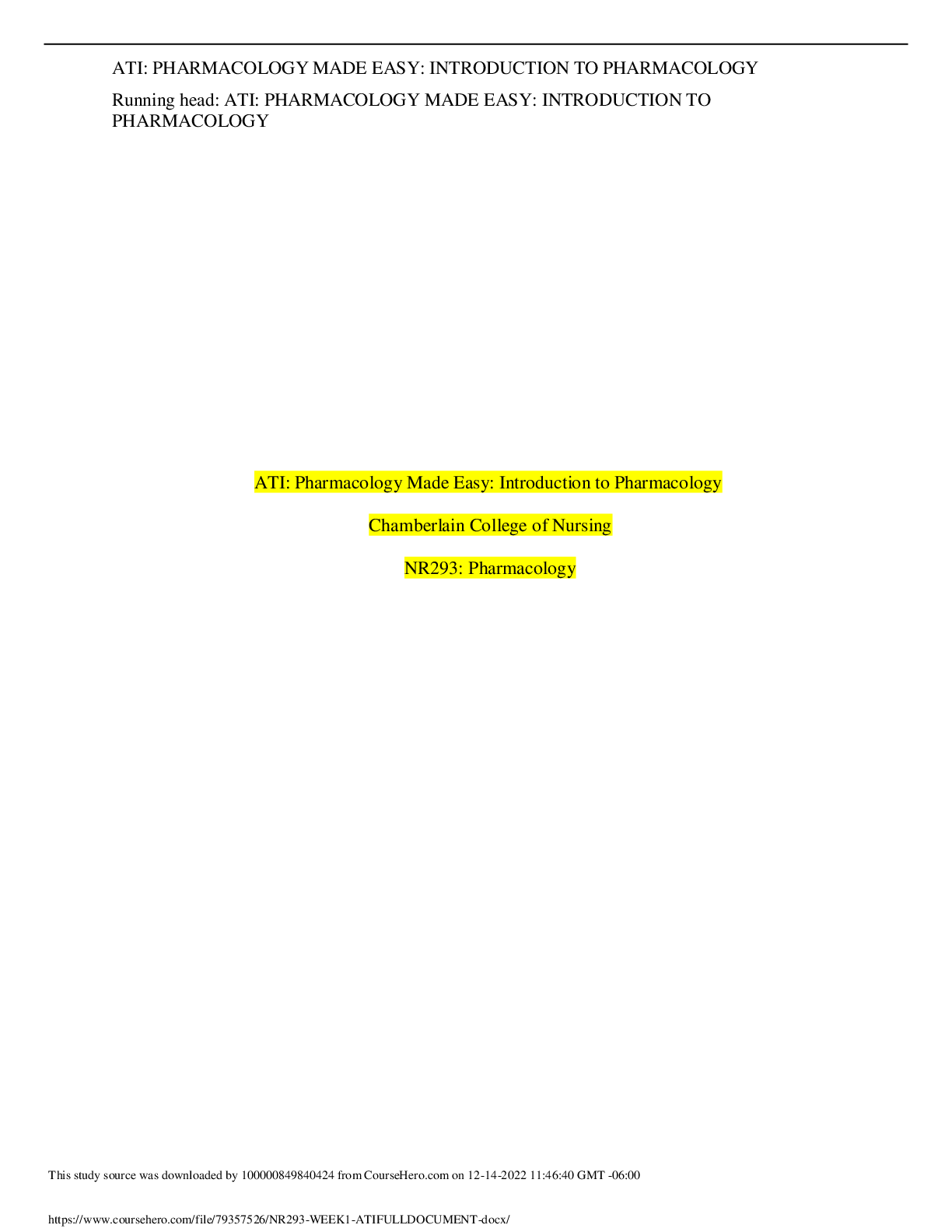
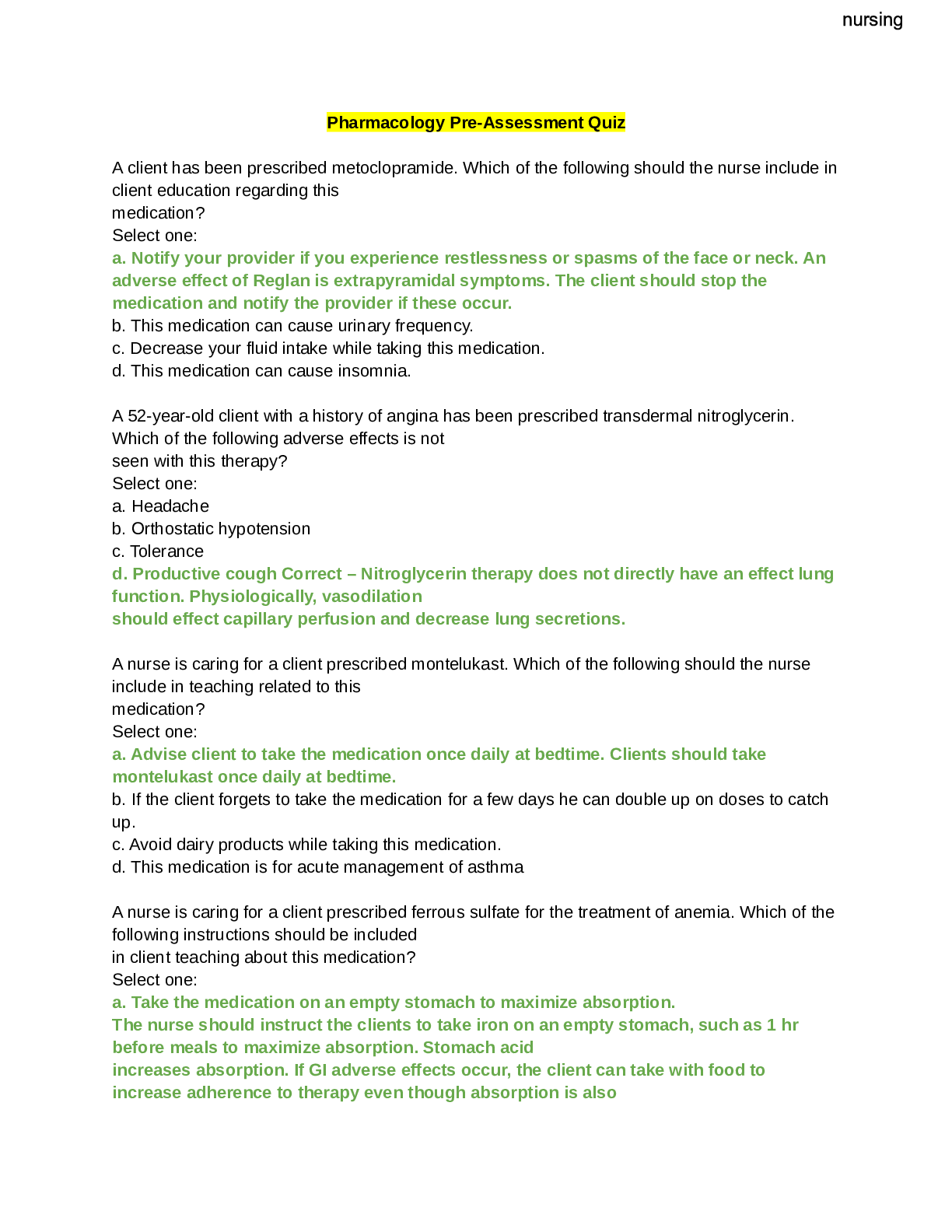
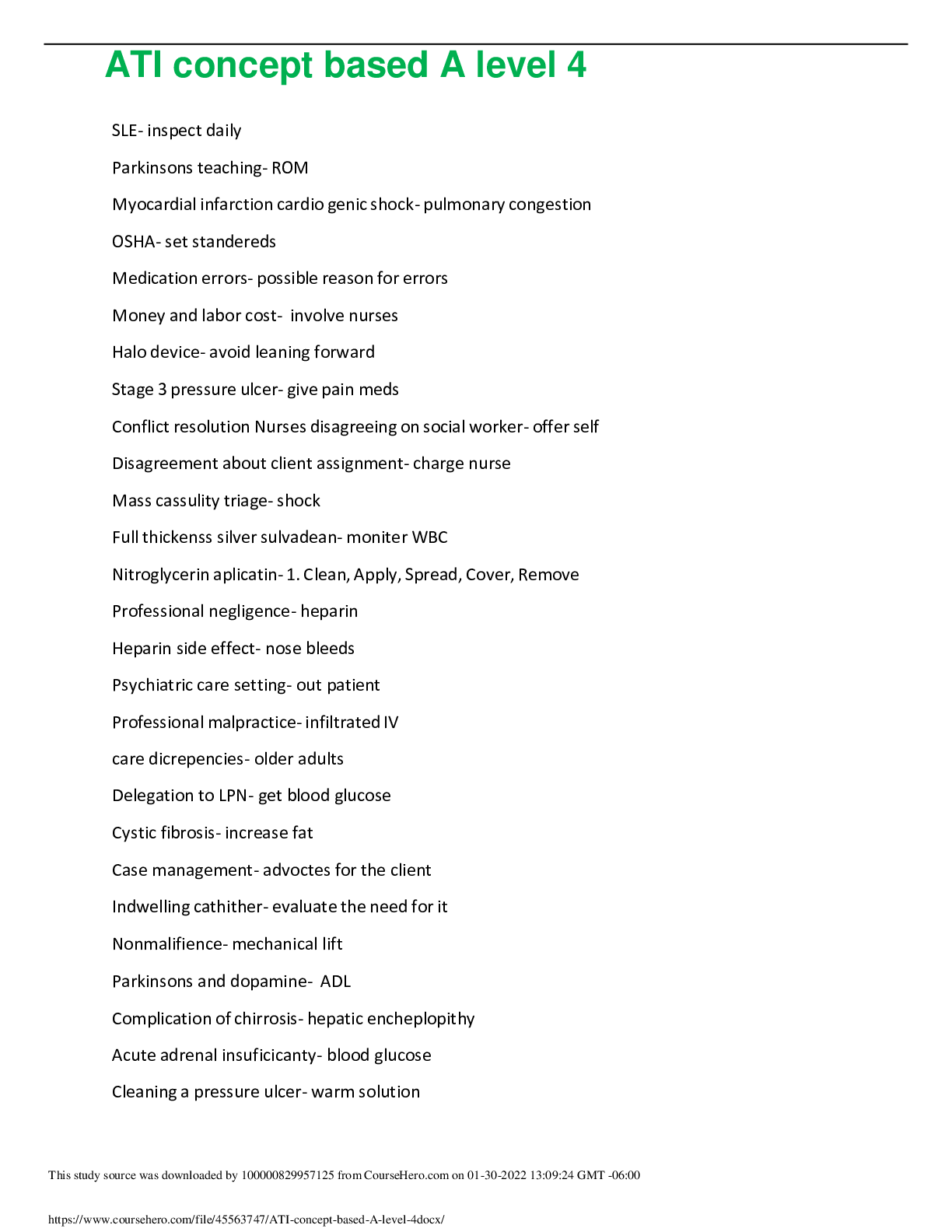
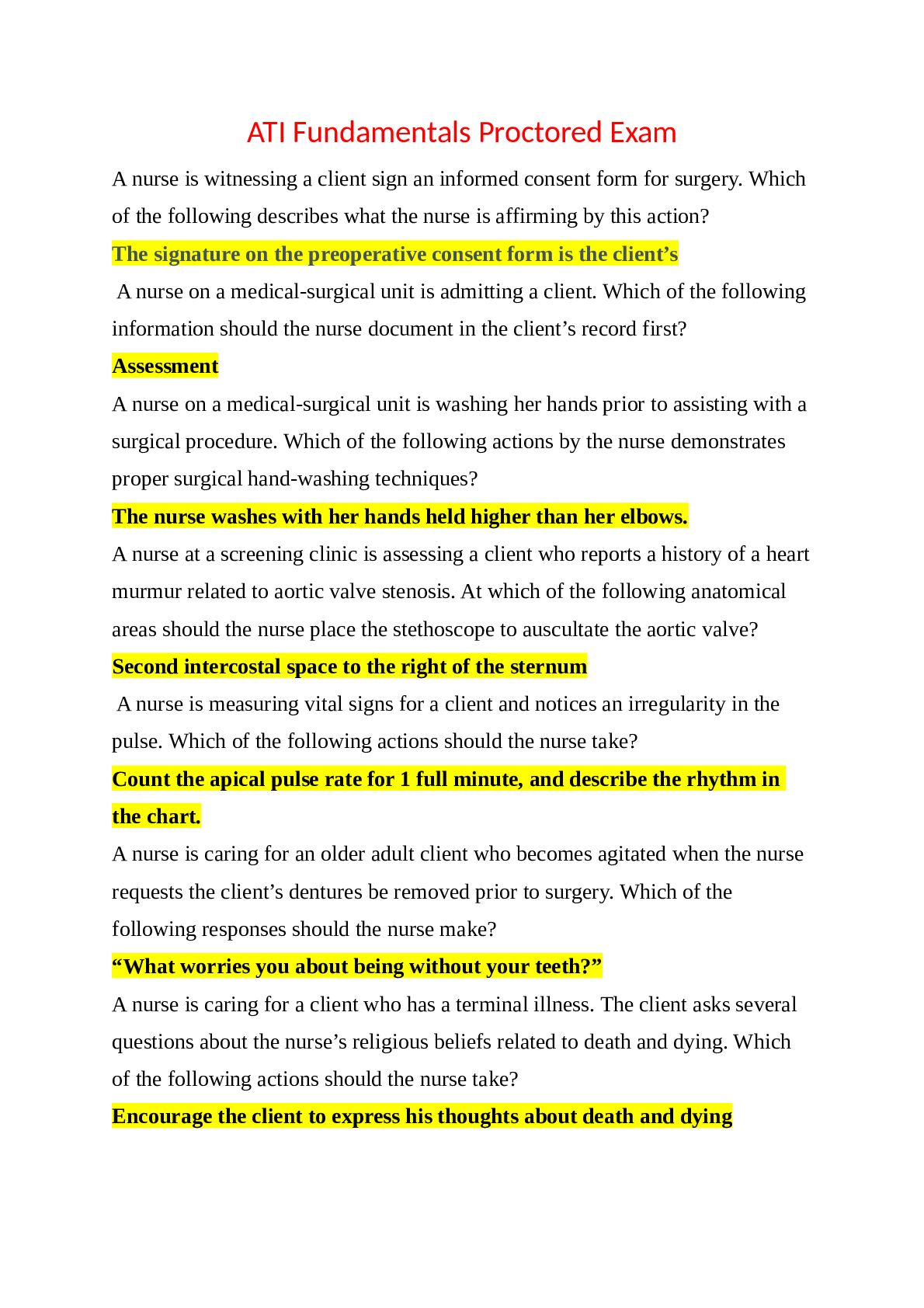
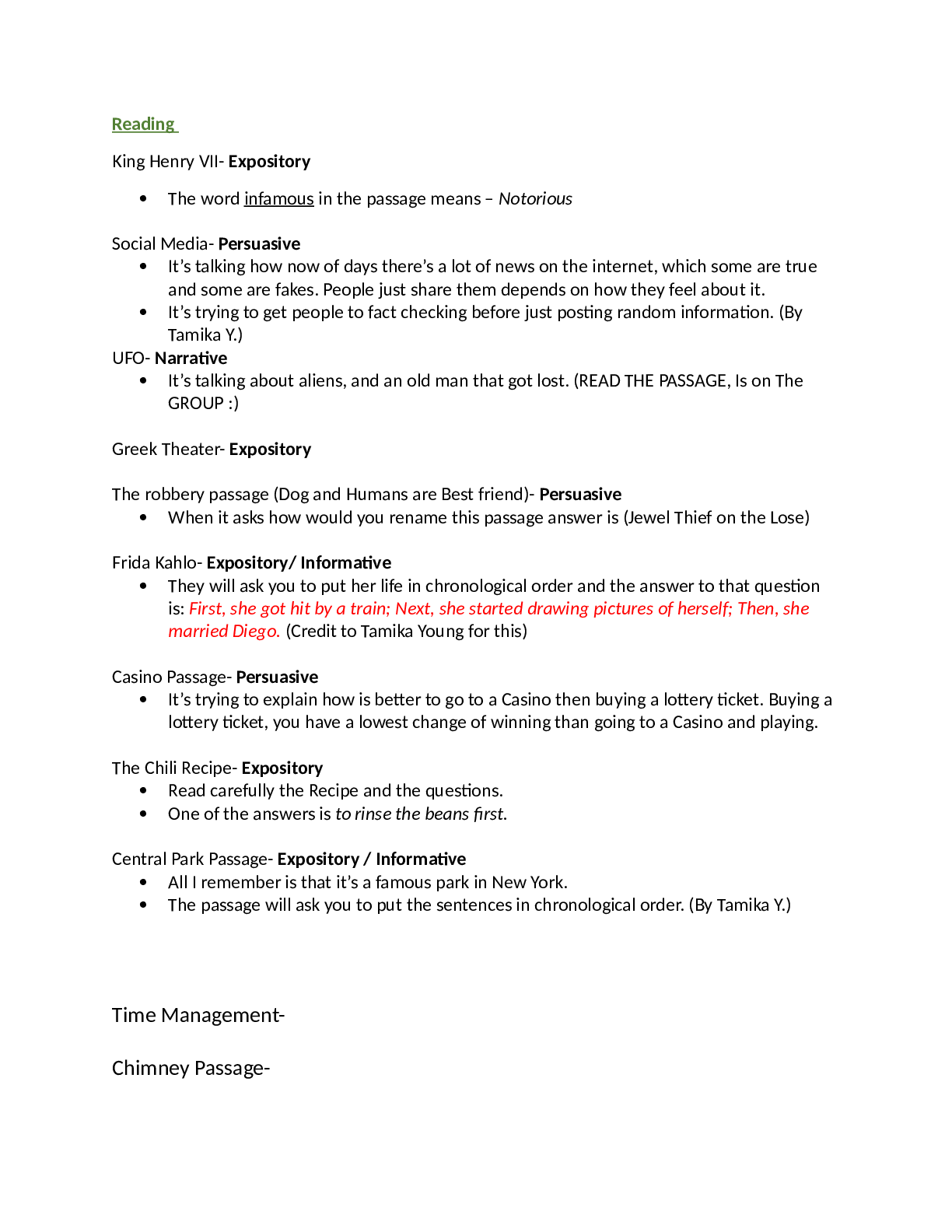
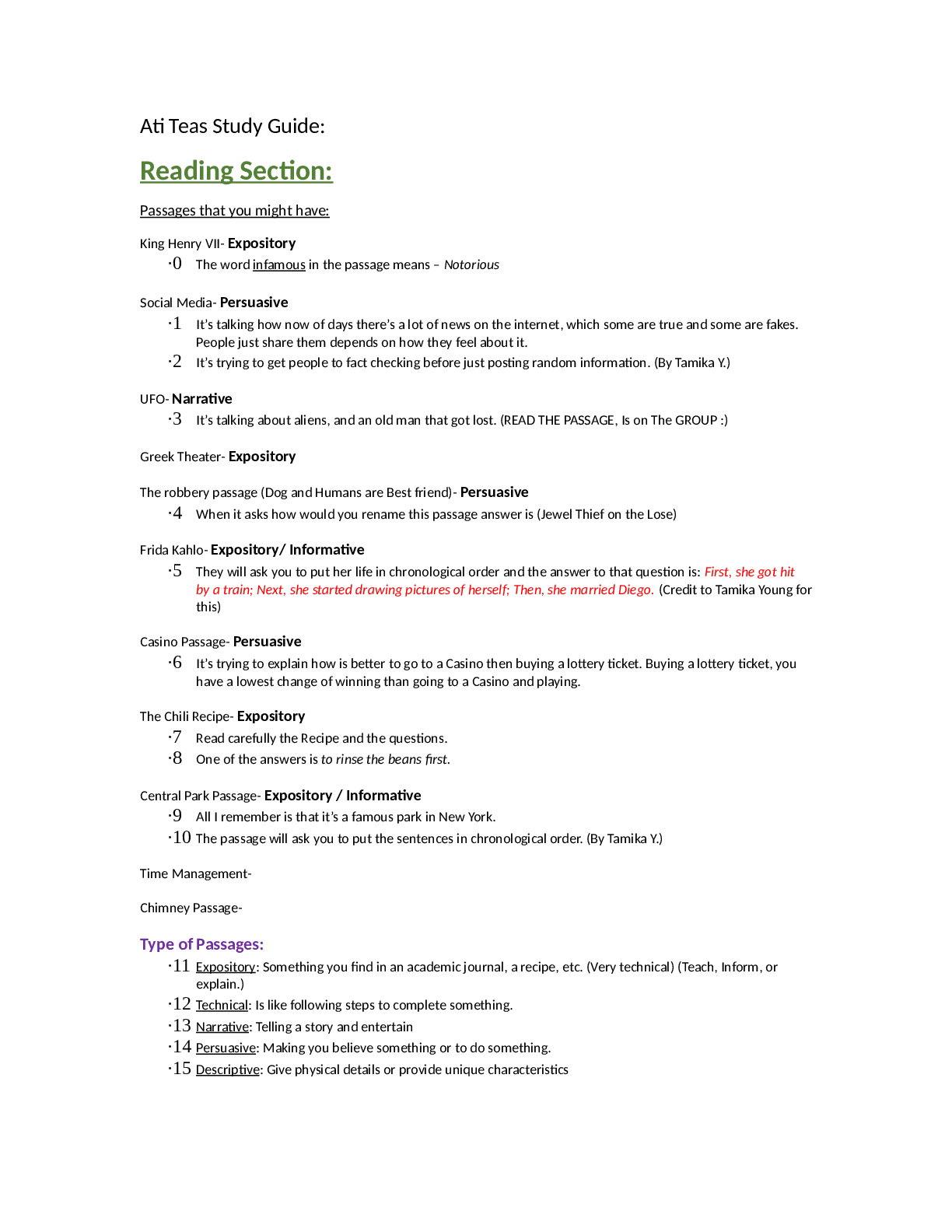
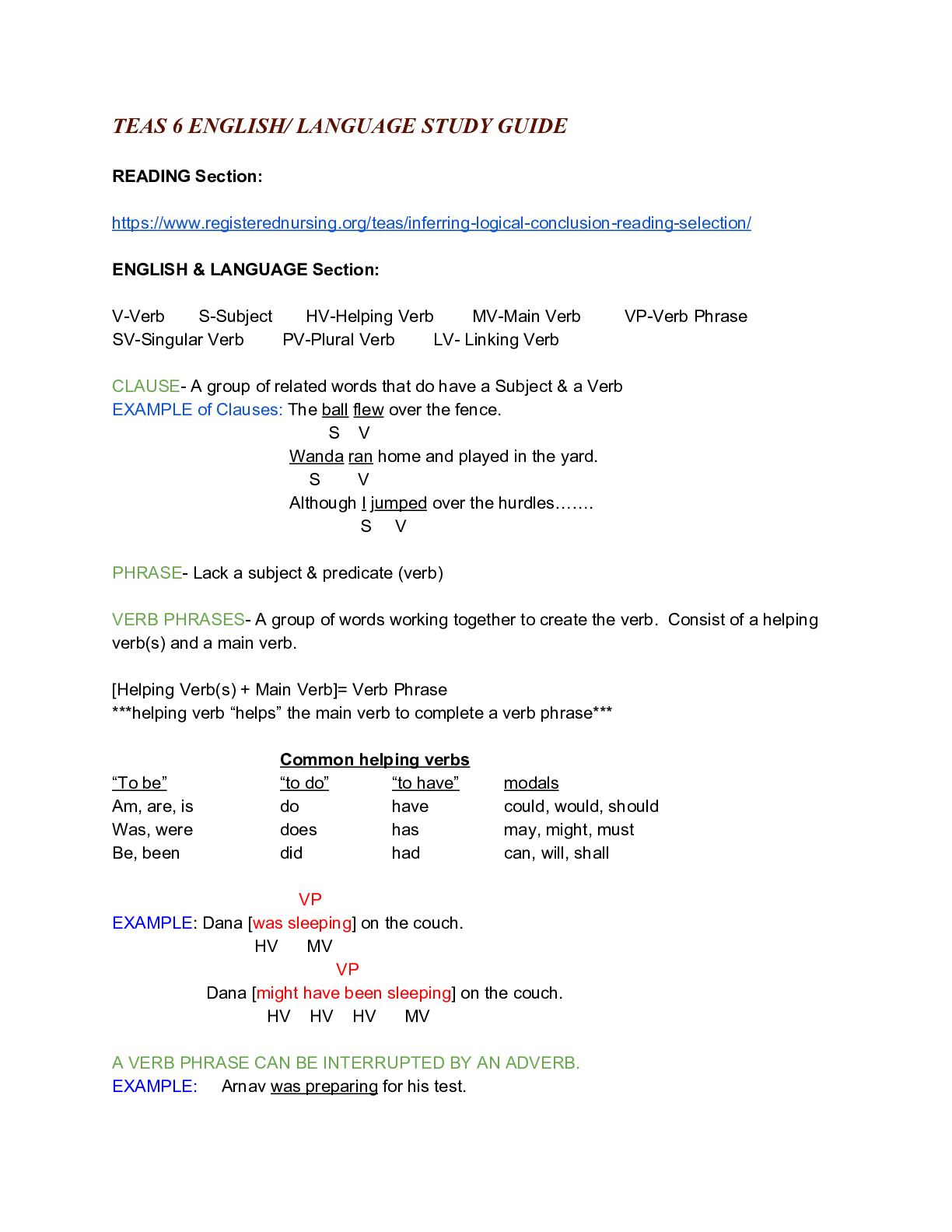
.png)
